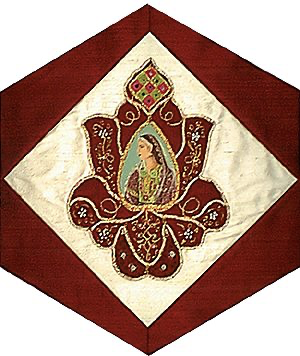Pakistan

The Block
Blockmaker Tehzib Morad has hand painted a miniature portrait of a Pakistani woman in traditional garb for the centre of this piece. Pakistani clothing incorporates many different styles of needlework and several of these techniques, generally associated with specific regions of the country, are represented in the silk and cotton fabrics surrounding the image. These techniques include gold-work, smooth and wire purl work, couching, beadwork and use of gold and silver cording. Embroidery is most often featured on shalwar kameez, the outfit worn by both men and women in Pakistan. The baggy shalwar, or trousers, and the kameez, a shirt of varying length, are usually made of colourful cotton, one of the country’s major crops.
Near the top of the piece is an example of Shishadar (mirror work), a process in which buttonhole stitches surround small pieces of silvered glass or mica, securing them to the fabric. The bottom displays a sampling of Ijkir, the hand-painted design on traditional red cotton associated with the Sind region. The shape of the piece is one typically incorporated into Pakistani clothing and is evident in much of the country’s architecture.
Cultural Profile
Pakistan, meaning ‘land of the pure,’ is a land of towering mountains, fertile valleys, rocky plateaus and pristine coastlines. The K2 mountain, the world’s second highest peak, is located there. The region has been inhabited since at least 125,000 BC. The official languages are Urdu and English. However, each of the four provinces into which the country is divided is home to different cultural groups with their own distinctive languages and customs.
Pakistani families are very close. The elderly are treated with great respect and children are considered to be gifts. Teaching them the beliefs of Islam is considered to be one of the most important responsibilities of family life. People are very hospitable, and it is their custom to offer chai (tea) to visitors.
Pakistan has a long tradition of art and poetry. The geometric patterns and designs in their art, especially in the architecture, are some of the most complex in the world. Unique to Pakistani cities are the paintings adorning the sides of buses and trucks reflecting a fascination with colour and abstract art forms.Writing has developed into an art form of its own within the culture.
Due to the country’s location and climate, vast amounts of textiles, as well as natural dyes are produced: it is the world’s fourth largest cotton producer, an important wool producer, and a major exporter of garments. Its textiles arts are varied and date back many centuries. The colourful Ralli quilts are made in the province of Sindh, either with patchwork, appliqué or embroidery. The large ajrak cloth displays elaborate, colourful geometric patterns obtained with block printing. A dazzling array of traditional fabrics are woven in Pakistan: daree, lungi, khes, farasi, loi, khaddar, palisk, khes and the taghar, traditional woolen rugs, are but some of the cloths made. There are also many types of looms used including pit looms, vertical looms, pedal looms, back strap looms and floor looms. The country is also known for its knotted rugs.
The country also produces a variety of brass and metal-ware, pottery engraved with elaborate designs and finely detailed basketry.
Pakistanis began coming to Canada after World War II, with over 13,000 arriving between 1967 and 1975. At first they were mainly professionals, but soon skilled and semi-skilled workers followed, and by the late 1970s Pakistani immigrants included a wide range of occupations. There are currently over 155,000 Pakistanis in Canada, living mainly in Toronto, Montreal and Vancouver. As their communities have grown, they have established a significant presence in the food industry as well as in accounting and finance. They support such organizations as the Pakistan-Canadian Association and Pakistani Student Associations on various university campuses.
Sponsor: Winn family, in memoriam Helen McMillan, Bruce McCuaig, Roger McNeal
